

Hiroshima Peace Memorial Museum. Dr.Takashi Nagai. The Life of Dr.Takashi Nagai and His Meeting with Nagasaki 1.

The Birth and Childhood of Dr.Takashi Nagai 2.The Achievements of Dr.Takashi Nagai 3.Nyoko-do and Nagai Memorial Museum 4.11th Medical Corps Mitsuyama Relief Station Nagai:4relief 5.Publications of Dr.Takashi Nagai 6.Chronology of the Life of Dr.Takashi Nagai 7.Dr.Takashi Nagai the Author Statue of Dr.Takashi Nagai Dr.Nagai stayed in mourning for six months after exposure to the atomic bombing,seeking "peace" and "restoration" in "prayer". Takashi Nagai. Takashi Nagai (永井 隆, Nagai Takashi?
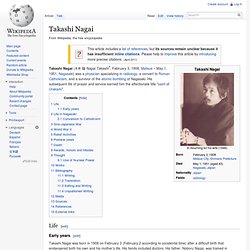
, February 3, 1908, Matsue – May 1, 1951, Nagasaki) was a physician specializing in radiology, a convert to Roman Catholicism, and a survivor of the atomic bombing of Nagasaki. His subsequent life of prayer and service earned him the affectionate title "saint of Urakami". Life[edit] Early years[edit] Takashi Nagai was born in 1908 on February 3 (February 2 according to occidental time) after a difficult birth that endangered both his own and his mother’s life. Tsutomu Yamaguchi. Tsutomu Yamaguchi (山口 彊, Yamaguchi Tsutomu?)
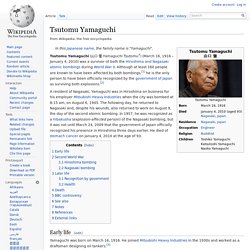
(March 16, 1916 – January 4, 2010) was a survivor of both the Hiroshima and Nagasaki atomic bombings during World War II. Although at least 160 people are known to have been affected by both bombings,[1] he is the only person to have been officially recognized by the government of Japan as surviving both explosions.[2] 2010 August 09 « Tokyo Five. Today is the sixty-fifth anniversary of the atomic bombing of 長崎 (Nagasaki, Japan).

Last year I wrote a post (click here) about the peace memorials in Hiroshima and Nagasaki. And three days ago, I wrote a post about the 65th anniversary of the attack on Hiroshima. In Nagasaki today there will be a peace ceremony just as there was in Hiroshima last Friday. DAD'S IMAGES OF DEATH. The photograph of a Japanese boy standing at attention with a child strapped to his back lay on the kitchen table.
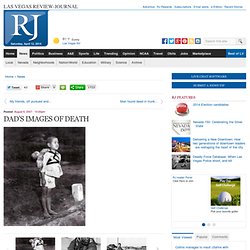
Tyge O'Donnell, then a college student, stared at the photo, suggesting to his father, Joe, that the infant hanging out of the makeshift baby carrier "looked sound asleep. " "No, son, he's not sleeping," O'Donnell recalls his father saying. "The little boy is dead. " O'Donnell, now a 37-year-old bellman at Caesars Palace, had grown up knowing his father primarily as a photographer for the White House and Marine Corps, but it wasn't until that moment in 1989 when he found out how closely his dad had chronicled the devastation wrought by the atomic bombs dropped on Hiroshima and Nagasaki. "I came into the house from my summer job at a hobby shop and there were these photos on the kitchen table," Tyge O'Donnell said. Joe O'Donnell (photojournalist) Joseph (Joe) Roger O'Donnell (May 7, 1922 – August 9, 2007) was an American documentarian, photojournalist and a photographer for the United States Information Agency.
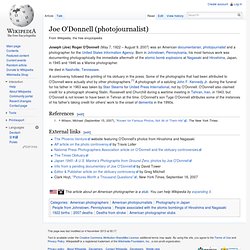
Born in Johnstown, Pennsylvania, his most famous work was documenting photographically the immediate aftermath of the atomic bomb explosions at Nagasaki and Hiroshima, Japan, in 1945 and 1946 as a Marine photographer. He died in Nashville, Tennessee. A controversy followed the printing of his obituary in the press. Some of the photographs that had been attributed to O'Donnell were actually shot by other photographers.[1] A photograph of a saluting John F.
Kennedy Jr. during the funeral for his father in 1963 was taken by Stan Stearns for United Press International, not by O'Donnell. The Phoenix Venture's Photostream. The Bombing of Hiroshima and Nagasaki. Excerpt from The Ultimate Weapon. Excerpt from The Ultimate Weapon: The Race to Develop the Atomic Bomb by Edward T.

Sullivan Weapons of Mass Destruction pdf "My God, what have we done? " -Captain Robert Lewis, Enola Gay co-pilot- A film crew surrounded Colonel Paul W. Enola Gay and two escort planes departed from the small Pacific island of Tinian at 2:45 A.M. local time on Monday, August 6, 1945. The weather was perfect. A column of smoke is rising fast. Gray in color with that red core. Hiroshima - Rain of Fire. Defending the Indefensible: A Meditation on the Life of Hiroshima Pilot Paul Tibbets, Jr. Defending the Indefensible: A Meditation on the Life of Hiroshima Pilot Paul Tibbets, Jr.
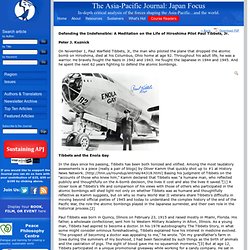
Peter J. Kuznick. Hiroshima and Nagasaki Remembered: The Story of Hiroshima. Hiroshima & Nagasaki Remembered 60 years later The Story of Hiroshima On August 6, 1945, an American B-29 bomber named the Enola Gay left the island of Tinian for Hiroshima, Japan.

This section recounts the first atomic bombing. Contents. Hiroshima and Nagasaki Remembered: Hiroshima Photographs. Let's look at the Special Exhibit. GETA:Black Rain. Japanese Title: Kuroi Ame English Title: Black Rain Director: Shohei Imamura Cast: Yoshiko Tanaka / Kazuo Kitamura / Etsuko Ichihara [1989 / B&W / Standard / Mono / 123 mins] RIGHTS SOLD IN FRENCH SPEKING COUNTRIES, US and Canada.
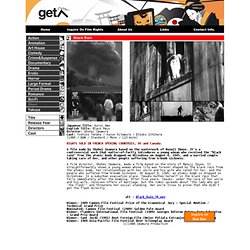
A film made by Shohei Imamura based on the masterwork of Masuji Ibuse. A film director, Shohei Imamura, made a film based on the story of Masuji Ibuse. Winner: 1989 Cannes Film Festival Prize of the Ecumenical Jury - Special Mention / Technical Grand PrizeNominated: Cannes Film Festival (1989) Golden Palm AwardWinner: Flanders International Film Festival (1989) Georges Delerue Prize: Toru Takemitsu / Grand Prix Award Winner: Sant Jordi (1991) Best Foreign Film (Mejor Peliula Extranjera): Shohei ImamuraWinner: 1989 Asia-Pacific Film Festival Best Screenplay Award (c)1988 Imamura Production. Damage of Radiation. Hiroshima Cultural Encyclopedia - Atomic Bomb(A-bomb) Literature -
Atomic Bomb Literature: A Bibliography. Misunderstanding Hiroshima 広島を誤解する. Misunderstanding Hiroshima Richard H. Minear, in conversation with Mark Selden Charles Pellegrino’s The Last Train from Hiroshima (Henry Holt, 2010)1 came highly touted. Its special claim to fame seemed to be its scientific background. The jacket identified the author as someone who “has contributed articles to many scientific journals based on his work in paleobiology, nuclear propulsion systems for space exploration, and forensic archaeology.” Despite all this cheerleading, Last Train is a train wreck. Tamiki Hara's Notes of the Atomic Bombing.
"Summer Flower" by Tamiki Hara. "Summer Flower" by Tamiki Hara is the second story included in The Crazy Iris and Other Stories of the Atomic Aftermath (edited and introduced by Kenzaburo Oe). I have already talked a bit about why I was so happy to acquire The Crazy Iris and Other Stories of the Atomic Aftermath in my post on the lead story, "The Crazy Iris". Tamiki Hora was in Hiroshima on the day the atomic bomb was exploded at Hiroshima August 6, 1945. He survived because he was far enough away from ground zero in the bathroom of a very well constructed house built by his father. "Summer Flowers" is an account of that day and the days right after the blast. A lot of us have probably seen movies about apocalyptic seeming events. One Stop To Read: In Hiroshima, there are permanent shadows caused by the intensity of the nuclear blast when the bomb was dropped. Hiroshima was an event that left both the emotional shadows of tragedy and also permanent physical shadows on the landscape of Hiroshima, Japan.
These shadows were created by the great force of the nuclear weapon. Thermal radiation travels in a straight line, which means that when it is blocked by an object it creates a shadow. These shadows still exist around Japan today. From atom bomb to earthquake. Hiroshima Poetry, Prose and Art. A Photo-Essay on the Bombing of Hiroshima and Nagasaki. A Photo-Essay on the Bombing of Hiroshima and Nagasaki Hiroshima Hiroshima, Japanese city, situated some 8M km. (500 mi.) from Tokyo, on which the first operational atomic bomb was dropped at 0815 on 6 August 1945. Nicknamed 'Little Boy’—a reference to Roosevelt—the bomb was 3 m. (9 ft. 9 in.) long, used uranium 235, had the power of 12.5 kilotons of TNT, and weighed 3,600 kg.
A Personal Record of Hiroshima A-bomb Survival(No.1) Justification of Hiroshima. Atomic bomb over Nagasaki "Hiroshima is justified: if the war had continued, additional lives would have been lost. Hiroshima cost fewer lives than it saved. " Well and good. But even putting rights talk to one side, and speaking only in terms of consequences, it is not at all clear that possible loss of life and suffering, had the war continued, outweigh the definite loss of life, and the definite suffering, that did occur. It is, moreover, misleading to speak of Hiroshima as if it were over, when it is still. HIROSHIMA; Justified Bombings? A Survivor's Reply. His ears are missing, his fingers are deformed and he is weakened by chronic illness, making Akihiro Takahashi a living testimonial to the horrific results of the atomic bomb that exploded over Hiroshima half a century ago. Mr. Was Hiroshima Necessary? Was Hiroshima Necessary? Why the Atomic Bombings Could Have Been Avoided By Mark Weber.
'Moral' Robots: the Future of War or Dystopian Fiction? - Research. By Don Troop.